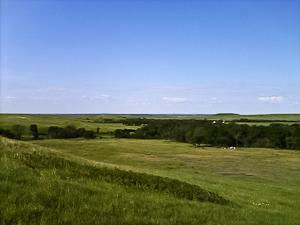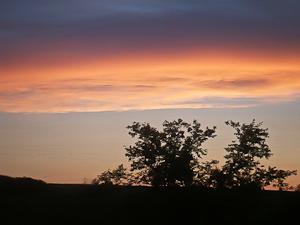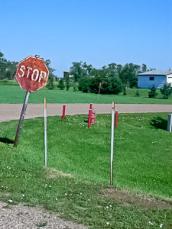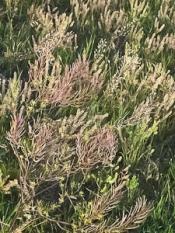

It's a seven-hundred-mile straight-shot west on I-90 from Barrington, Illinois – a Chicago suburb and my hometown – to the reservation in South Dakota. A thirteen-hour drive through the vast farmlands of Wisconsin, Minnesota and eastern South Dakota and a single right turn off the highway lead to the small, blue-collar town of Chamberlain. Americana gives way to faded green hills specked with patches of hard, sandy dirt. A two-lane road climbs and dips along the edge of a valley leading to the lazy Missouri River. Farm houses and small herds of cattle and horses dotting the landscape are the only indication of a human presence on the treeless expanse.
Twenty miles down the road, scattered shacks, beat up trucks and muddy toys disrupt the scenery. A small government sign on the side of the road points to the reservation's entrance. A gas station/grocery store and casino form the town's main intersection, and provide measly employment opportunities for most of the reservation's Lakota people. Clustered neighborhoods of boarded, dilapidated houses surround the casino. Chain-fenced yards are crowded with cars and furniture – left to rust and rot under harsh weather conditions. Wind-swept country reemerges once outside the town; the paved roads become gravel and cross the hills. A knobby rollercoaster of a drive leads to a white fence heading over a ridge. Cowboy boots nailed to the side of the fence mark the driveway of a petite, one-room house atop a hill. This is home to the community elders, and it is their land I stayed on during my three summers at Crow Creek.

There are many reasons for taking groups of highly advantaged kids to one of the poorest places in the United States. While trucks full of donated supplies are brought to the reservation, the trips are not simply charity-based. Complete immersion by students in the Lakota culture and their full participation in unique educational opportunities help preserve an appreciation for the tribe and its customs. This is the main goal of The Brother's Keeper program; another is to effect camaraderie between two very different cultures.
The problems of the reservation – drugs, alcohol, suicide, unemployment, lack of education – are the result of an ever-present hopelessness, which seems an inherent part of reservation life. A lost generation has formed on Crow Creek, with a disproportionately high percentage of men in the community either deceased or incarcerated. The young people on the reservation often grow up without positive influences and can lose sight of their native connection to the spirit of the land.

This relationship can be appreciated during the spellbinding Sundance ritual and the harvesting of its sacred tree. Every summer, four men are chosen to dance following a long and strenuous cleansing process. After two trips to the reservation, a friend and I were granted the opportunity to witness the weeklong ceremony. Being allowed to view this – the most sacred of Lakota ceremonies – was a towering honor for us. The purpose of the Sundance is for dancers to sacrifice their personal wellbeing; individuals suffer so the tribe will have blessings in the year to come. The Sundance Tree, at the center of the ceremony, serves the same purpose. The Lakota consider all plants and animals to be sacred beings – equal in importance to the Creator. When the tree falls, its spirit is sacrificed. The tribe's "wounds" are thereby healed and suffering is eased.
Of all the things I tell people about my time on Crow Creek, the sweat lodge evokes the most curiosity. When I describe the experience, I realize my own curiosity is greatest of all. I have participated in more than a dozen sweats, each one unique in emotion and outcome. Sweats are a purification ceremony, whereby a group sits in a circle inside what looks like a wooden igloo covered with heavy blankets. Sacred stones have been heated in a fire to the point of cracking. The raging orange rocks are then set in the middle of the circle, providing a glow in the darkness. A spiritual leader of the tribe then conducts the ceremony; he determines the temperature and length of time spent in the lodge, based on the group's emotional and physical needs. Even in the shortest of sweats with the fewest of rocks, I was the hottest I've ever felt and I sweat more than ever before. During the ceremony, the leader chants and beats on a buffalo skin drum. He offers the participants a chance for silent or open prayer, or to give thanks. Sage, herbs and water crackle and steam when placed on the stones. A pipe full of tobacco and various tree barks is passed and smoked. Into the air and up to the Creator go our prayers and thoughts with the exhaled smoke.
In the moments after a sweat – outside in the crisp prairie night – the Lakota's connection to the land is truly felt. During my first summer, I had a broken foot and wore a walking cast. After a sweat, I could easily walk without pain. And with each subsequent sweat came a healing of sorts. My awful eyesight, for example, grew clear for a prolonged time. There was a great clarity of the senses; I could hear every blade of grass flutter, every tree leaf bend in the breeze. All traditional Lakota ceremonies evoke the spirit of the land, but the complex purification ritual of the sweat is especially powerful, even mind-blowing.
The intense poverty and complicated social issues facing the Lakota people are ominous reminders of their historical hardships. In spite of such difficulties, hope for prosperity endures. The Lakota tribe's deep-rooted connection to the spirit of land and the traditions that use the spirit for healing, ultimately, empower the people. And with this empowerment and the inspiration it provides, their culture, thankfully, survives.
Photos are copyright protected and may not reproduced without permission. Photos are used with the permission of Matt Kasik.